LSD1-Based Reversible Inhibitors Virtual Screening and Binding Mechanism Computational Study
Abstract
:1. Introduction
2. Results and Discussion
2.1. Structure-Based Virtual Screening (SBVS)
2.1.1. Drug-Likeness and ADMET Screening
2.1.2. Molecular Docking Studies
Selection of Docking Methods
Docking Screening
2.1.3. Screening Based on Binding Free Energy Calculations
2.1.4. Binding Mode Analysis
2.2. Ligand-Based Virtual Screening (LBVS)
2.2.1. Pharmacophore Model Generation
2.2.2. Pharmacophore Model Validation
Cost Analysis
Test Set Validation
Fischer’s Randomization Test Analysis
2.2.3. Drug-Likeness Screening
2.2.4. Screening Based on Docking, ADMET and Binding Free Energy
2.2.5. Binding Modes Analysis
3. Materials and Methods
3.1. Database Preparation
3.2. Structure-Based Virtual Screening (SBVS)
3.2.1. The Binding Site of LSD1 Receptor
3.2.2. Molecular Docking Study in SBVS
3.3. Ligand-Based Virtual Screening
3.3.1. Training Set and Test Set Preparation
3.3.2. Pharmacophore Model Generation
3.3.3. Pharmacophore Model Validation
Cost Analysis
Test Set Validation
Fischer’s Randomization Test
3.4. Molecular Docking Study in LBVS
3.5. ADMET Screening
3.6. Molecular Dynamics Simulations
3.7. Binding Free Energy Calculations
4. Conclusions
Supplementary Materials
Author Contributions
Funding
Institutional Review Board Statement
Informed Consent Statement
Data Availability Statement
Conflicts of Interest
Sample Availability
References
- Shi, Y.; Lan, F.; Matson, C.; Mulligan, P.; Whetstine, J.R.; Cole, P.A.; Casero, R.A.; Shi, Y. Histone demethylation mediated by the nuclear amine oxidase homolog LSD1. Cell 2004, 119, 941–953. [Google Scholar] [CrossRef] [PubMed] [Green Version]
- Lokken, A.A.; Zeleznik-Le, N.J. Breaking the LSD1/KDM1A addiction: Therapeutic targeting of the epigenetic modifier in AML. Cancer Cell 2012, 21, 451–453. [Google Scholar] [CrossRef] [PubMed] [Green Version]
- Magerl, C.; Ellinger, J.; Braunschweig, T.; Kremmer, E.; Koch, L.K.; Holler, T.; Buttner, R.; Luscher, B.; Gutgemann, I. H3K4 dimethylation in hepatocellular carcinoma is rare compared with other hepatobiliary and gastrointestinal carcinomas and correlates with expression of the methylase Ash2 and the demethylase LSD1. Hum. Pathol. 2010, 41, 181–189. [Google Scholar] [CrossRef] [PubMed]
- Schulte, J.H.; Lim, S.; Schramm, A.; Friedrichs, N.; Koster, J.; Versteeg, R.; Ora, I.; Pajtler, K.; Klein-Hitpass, L.; Kuhfittig-Kulle, S.; et al. Lysine-specific demethylase 1 is strongly expressed in poorly differentiated neuroblastoma: Implications for therapy. Cancer Res. 2009, 69, 2065–2071. [Google Scholar] [CrossRef] [Green Version]
- Wang, Y.; Zhang, H.; Chen, Y.; Sun, Y.; Yang, F.; Yu, W.; Liang, J.; Sun, L.; Yang, X.; Shi, L.; et al. LSD1 is a subunit of the NuRD complex and targets the metastasis programs in breast cancer. Cell 2009, 138, 660–672. [Google Scholar] [CrossRef] [Green Version]
- Zheng, Y.C.; Ma, J.; Wang, Z.; Li, J.; Jiang, B.; Zhou, W.; Shi, X.; Wang, X.; Zhao, W.; Liu, H.M. A systematic review of histone Lysine-specific demethylase 1 and its inhibitors. Med. Res. Rev. 2015, 35, 1032–1071. [Google Scholar] [CrossRef]
- Aravind, L.; Iyer, L.M. The SWIRM domain: A conserved module found in chromosomal proteins points to novel chromatin-modifying activities. Genome Biol. 2002, 3, research0039. [Google Scholar] [CrossRef]
- Maiques-Diaz, A.; Somervaille, T.C. LSD1: Biologic roles and therapeutic targeting. Epigenomics 2016, 8, 1103–1116. [Google Scholar] [CrossRef] [Green Version]
- Anand, R.; Marmorstein, R. Structure and mechanism of lysine-specific demethylase enzymes. J. Biol. Chem. 2007, 282, 35425–35429. [Google Scholar] [CrossRef] [Green Version]
- Song, Y.H.; Zhang, H.Q.; Yang, X.K.; Shi, Y.T.; Yu, B. Annual review of lysine-specific demethylase 1 (LSD1/KDM1A) inhibitors in 2021. Eur. J. Med. Chem. 2022, 228, 114042. [Google Scholar] [CrossRef]
- Maes, T.; Mascaro, C.; Tirapu, I.; Estiarte, A.; Ciceri, F.; Lunardi, S.; Guibourt, N.; Perdones, A.; Lufino, M.M.P.; Somervaille, T.C.P.; et al. ORY-1001, a potent and selective covalent KDM1A inhibitor, for the treatment of acute leukemia. Cancer Cell 2018, 33, 495–511 e12. [Google Scholar] [CrossRef] [PubMed] [Green Version]
- Mohammad, H.; Smitheman, K.; Van Aller, G.; Cusan, M.; Kamat, S.; Liu, Y.; Johnson, N.; Hann, C.; Armstrong, S.; Kruger, R. 212 Novel anti-tumor activity of targeted LSD1 inhibition by GSK2879552. Eur. J. Cancer 2014, 50, 72. [Google Scholar] [CrossRef]
- Mohammad, H.P.; Smitheman, K.N.; Kamat, C.D.; Soong, D.; Federowicz, K.E.; Van Aller, G.S.; Schneck, J.L.; Carson, J.D.; Liu, Y.; Butticello, M.; et al. A DNA hypomethylation signature predicts antitumor activity of LSD1 inhibitors in SCLC. Cancer Cell 2015, 28, 57–69. [Google Scholar] [CrossRef] [PubMed] [Green Version]
- Wen, L.; Chen, Y.; Zeng, L.L.; Zhao, F.; Li, R.; Liu, Y.; Zhang, C. Triptolide induces cell-cycle arrest and apoptosis of human multiple myeloma cells in vitro via altering expression of histone demethylase LSD1 and JMJD2B. Acta Pharmacol. Sin. 2012, 33, 109–119. [Google Scholar] [CrossRef] [PubMed]
- Ota, Y.; Itoh, Y.; Kaise, A.; Ohta, K.; Endo, Y.; Masuda, M.; Sowa, Y.; Sakai, T.; Suzuki, T. Targeting cancer with PCPA-Drug conjugates: LSD1 inhibition-triggered release of 4-hydroxytamoxifen. Angew. Chem. Int. Ed. Engl. 2016, 55, 16115–16118. [Google Scholar] [CrossRef]
- Wang, M.; Liu, X.; Jiang, G.; Chen, H.; Guo, J.; Weng, X. Relationship between LSD1 expression and E-cadherin expression in prostate cancer. Int. Urol. Nephrol. 2015, 47, 485–490. [Google Scholar] [CrossRef]
- Wu, F.; Zhou, C.; Yao, Y.; Wei, L.; Feng, Z.; Deng, L.; Song, Y. 3-(Piperidin-4-ylmethoxy)pyridine containing compounds are potent inhibitors of lysine specific demethylase 1. J. Med. Chem. 2016, 59, 253–263. [Google Scholar] [CrossRef] [Green Version]
- Ma, L.; Wang, H.; You, Y.; Ma, C.; Liu, Y.; Yang, F.; Zheng, Y.; Liu, H. Exploration of 5-cyano-6-phenylpyrimidin derivatives containing an 1,2,3-triazole moiety as potent FAD-based LSD1 inhibitors. Acta Pharm. Sin. B 2020, 10, 1658–1668. [Google Scholar] [CrossRef]
- Mould, D.P.; Alli, C.; Bremberg, U.; Cartic, S.; Jordan, A.M.; Geitmann, M.; Maiques-Diaz, A.; McGonagle, A.E.; Somervaille, T.C.P.; Spencer, G.J.; et al. Development of (4-Cyanophenyl)glycine derivatives as reversible inhibitors of lysine specific demethylase 1. J. Med. Chem. 2017, 60, 7984–7999. [Google Scholar] [CrossRef] [Green Version]
- Niwa, H.; Sato, S.; Hashimoto, T.; Matsuno, K.; Umehara, T. Crystal structure of LSD1 in complex with 4-[5-(Piperidin-4-ylmethoxy)-2-(p-tolyl)pyridin-3-yl]benzonitrile. Molecules 2018, 23, 1538. [Google Scholar] [CrossRef] [Green Version]
- Kutz, C.J.; Holshouser, S.L.; Marrow, E.A.; Woster, P.M. 3,5-Diamino-1,2,4-triazoles as a novel scaffold for potent, reversible LSD1 (KDM1A) inhibitors. Medchemcomm 2014, 5, 1863–1870. [Google Scholar] [CrossRef] [PubMed] [Green Version]
- Mould, D.P.; Bremberg, U.; Jordan, A.M.; Geitmann, M.; Maiques-Diaz, A.; McGonagle, A.E.; Small, H.F.; Somervaille, T.C.P.; Ogilvie, D. Development of 5-hydroxypyrazole derivatives as reversible inhibitors of lysine specific demethylase 1. Bioorg. Med. Chem. Lett. 2017, 27, 3190–3195. [Google Scholar] [CrossRef] [PubMed]
- Mould, D.P.; Bremberg, U.; Jordan, A.M.; Geitmann, M.; McGonagle, A.E.; Somervaille, T.C.P.; Spencer, G.J.; Ogilvie, D.J. Development and evaluation of 4-(pyrrolidin-3-yl)benzonitrile derivatives as inhibitors of lysine specific demethylase 1. Bioorg. Med. Chem. Lett. 2017, 27, 4755–4759. [Google Scholar] [CrossRef] [PubMed] [Green Version]
- Soldi, R.; Ghosh Halder, T.; Weston, A.; Thode, T.; Drenner, K.; Lewis, R.; Kaadige, M.R.; Srivastava, S.; Daniel Ampanattu, S.; Rodriguez Del Villar, R.; et al. The novel reversible LSD1 inhibitor SP-2577 promotes anti-tumor immunity in SWItch/Sucrose-NonFermentable(SWI/SNF) complex mutated ovarian cancer. PLoS ONE 2020, 15, e0235705. [Google Scholar] [CrossRef]
- Sorna, V.; Theisen, E.R.; Stephens, B.; Warner, S.L.; Bearss, D.J.; Vankayalapati, H.; Sharma, S. High-throughput virtual screening identifies novel N’-(1-phenylethylidene)-benzohydrazides as potent, specific, and reversible LSD1 inhibitors. J. Med. Chem. 2013, 56, 9496–9508. [Google Scholar] [CrossRef]
- Kanouni, T.; Severin, C.; Cho, R.W.; Yuen, N.Y.; Xu, J.; Shi, L.; Lai, C.; Del Rosario, J.R.; Stansfield, R.K.; Lawton, L.N.; et al. Discovery of CC-90011: A potent and selective reversible inhibitor of lysine specific demethylase 1 (LSD1). J. Med. Chem. 2020, 63, 14522–14529. [Google Scholar] [CrossRef]
- Baron, R.; Vellore, N.A. LSD1/CoREST reversible opening-closing dynamics: Discovery of a nanoscale clamp for chromatin and protein binding. Biochemistry 2012, 51, 3151–3153. [Google Scholar] [CrossRef]
- Zhou, C.; Kang, D.; Xu, Y.; Zhang, L.; Zha, X. Identification of novel selective lysine-specific demethylase 1 (LSD1) inhibitors using a pharmacophore-based virtual screening combined with docking. Chem. Biol. Drug Des. 2015, 85, 659–671. [Google Scholar] [CrossRef]
- Debnath, A.K. Pharmacophore mapping of a series of 2,4-Diamino-5-deazapteridine inhibitors of mycobacterium avium complex dihydrofolate reductase. J. Med. Chem. 2002, 45, 41–53. [Google Scholar] [CrossRef]
- Debnath, A.K. Generation of predictive pharmacophore models for CCR5 antagonists: Study with piperidine- and piperazine-based compounds as a new class of HIV-1 entry inhibitors. J. Med. Chem. 2004, 47, 768. [Google Scholar] [CrossRef] [Green Version]
- Sakkiah, S.; Thangapandian, S.; John, S.; Kwon, Y.J.; Lee, K.W. 3D QSAR pharmacophore based virtual screening and molecular docking for identification of potential HSP90 inhibitors. Eur. J. Med. Chem. 2010, 45, 2132–2140. [Google Scholar] [CrossRef] [PubMed]
- Lipinski, C.A. Lead- and drug-like compounds: The rule-of-five revolution. Drug Discov. Today Technol. 2004, 1, 337–341. [Google Scholar] [CrossRef] [PubMed]
- Veber, D.F.; Johnson, S.R.; Cheng, H.-Y.; Smith, B.R.; Ward, K.W.; Kopple, K.D. Molecular properties that influence the oral bioavailability of drug candidates. J. Med. Chem. 2002, 45, 2615–2623. [Google Scholar] [CrossRef] [PubMed]
- Fowler, L.R.; Morain, S.R. Schrödinger’s App. Am. J. Law. Med. 2020, 46, 203–218. [Google Scholar] [CrossRef]
- Morris, G.M.; Huey, R.; Lindstrom, W.; Sanner, M.F.; Belew, R.K.; Goodsell, D.S.; Olson, A.J. AutoDock4 and AutoDockTools4: Automated docking with selective receptor flexibility. J. Comput. Chem. 2009, 30, 2785–2791. [Google Scholar] [CrossRef] [PubMed] [Green Version]
- Duan, Y.C.; Guan, Y.Y.; Zhai, X.Y.; Ding, L.N.; Qin, W.P.; Shen, D.D.; Liu, X.Q.; Sun, X.D.; Zheng, Y.C.; Liu, H.M. Discovery of resveratrol derivatives as novel LSD1 inhibitors: Design, synthesis and their biological evaluation. Eur. J. Med. Chem. 2017, 126, 246–258. [Google Scholar] [CrossRef]
- Li, Y.; Sun, Y.; Zhou, Y.; Li, X.; Zhang, H.; Zhang, G. Discovery of orally active chalcones as histone lysine specific demethylase 1 inhibitors for the treatment of leukaemia. J. Enzyme Inhib. Med. Chem. 2021, 36, 207–217. [Google Scholar] [CrossRef]
- Li, Z.R.; Wang, S.; Yang, L.; Yuan, X.H.; Suo, F.Z.; Yu, B.; Liu, H.M. Experience-based discovery (EBD) of aryl hydrazines as new scaffolds for the development of LSD1/KDM1A inhibitors. Eur. J. Med. Chem. 2019, 166, 432–444. [Google Scholar] [CrossRef]
- Romussi, A.; Cappa, A.; Vianello, P.; Brambillasca, S.; Cera, M.R.; Dal Zuffo, R.; Faga, G.; Fattori, R.; Moretti, L.; Trifiro, P.; et al. Discovery of reversible inhibitors of KDM1A efficacious in acute myeloid leukemia models. ACS Med. Chem. Lett. 2020, 11, 754–759. [Google Scholar] [CrossRef]
- Sartori, L.; Mercurio, C.; Amigoni, F.; Cappa, A.; Faga, G.; Fattori, R.; Legnaghi, E.; Ciossani, G.; Mattevi, A.; Meroni, G.; et al. Thieno[3,2-b]pyrrole-5-carboxamides as new reversible inhibitors of histone lysine demethylase KDM1A/LSD1. Part 1: High-throughput screening and preliminary exploration. J. Med. Chem. 2017, 60, 1673–1692. [Google Scholar] [CrossRef]
- Vianello, P.; Sartori, L.; Amigoni, F.; Cappa, A.; Faga, G.; Fattori, R.; Legnaghi, E.; Ciossani, G.; Mattevi, A.; Meroni, G.; et al. Thieno[3,2-b]pyrrole-5-carboxamides as new reversible inhibitors of histone lysine demethylase KDM1A/LSD1. Part 2: Structure-based drug design and structure-activity relationship. J. Med. Chem. 2017, 60, 1693–1715. [Google Scholar] [CrossRef]
- Huang, J.; Rauscher, S.; Nawrocki, G.; Ran, T.; Feig, M.; De Groot, B.L.; Grubmuller, H.; MacKerell, A.D., Jr. CHARMM36m: An improved force field for folded and intrinsically disordered proteins. Nat. Methods 2017, 14, 71–73. [Google Scholar] [CrossRef] [PubMed] [Green Version]
- Schuster, D.; Laggner, C.; Steindl, T.M.; Palusczak, A.; Hartmann, R.W.; Langer, T. Pharmacophore modeling and in silico screening for new P450 19 (aromatase) inhibitors. J. Chem. Inf. Model. 2006, 46, 1301–1311. [Google Scholar] [CrossRef] [PubMed]
- Kurogi1, Y.; Güner, O.F. Pharmacophore modeling and three-dimensional database searching for drug design using catalyst. Curr. Med. Chem. 2001, 8, 1035–1055. [Google Scholar] [CrossRef]
- Paliwal, S.; Pal, M.; Yadav, D.; Singh, S.; Yadav, R. Ligand-based drug design studies using predictive pharmacophore model generation on 4H-1,2,4-triazoles as AT1 receptor antagonists. Med. Chem. Res. 2011, 21, 2307–2315. [Google Scholar] [CrossRef]
- Tromelin, A.; Guichard, E. Use of catalyst in a 3D-QSAR study of the interactions between flavor compounds and β-Lactoglobulin. J. Agric. Food Chem. 2003, 51, 1977–1983. [Google Scholar] [CrossRef]
- Chopra, M.; Gupta, R.; Gupta, S.; Saluja, D. Molecular modeling study on chemically diverse series of cyclooxygenase-2 selective inhibitors: Generation of predictive pharmacophore model using catalyst. J. Mol. Model. 2008, 14, 1087–1099. [Google Scholar] [CrossRef] [PubMed]
- Xiong, G.; Wu, Z.; Yi, J.; Fu, L.; Yang, Z.; Hsieh, C.; Yin, M.; Zeng, X.; Wu, C.; Lu, A.; et al. ADMETlab 2.0: An integrated online platform for accurate and comprehensive predictions of ADMET properties. Nucleic Acids Res. 2021, 49, W5–W14. [Google Scholar] [CrossRef] [PubMed]
- Baell, J.B.; Holloway, G.A. New substructure filters for removal of pan assay interference compounds (PAINS) from screening libraries and for their exclusion in bioassays. J. Med. Chem. 2010, 53, 2719–2740. [Google Scholar] [CrossRef] [Green Version]
- Gotz, A.W.; Williamson, M.J.; Xu, D.; Poole, D.; Le Grand, S.; Walker, R.C. Routine microsecond molecular dynamics simulations with AMBER on GPUs. 1. Generalized Born. J. Chem. Theory Comput. 2012, 8, 1542–1555. [Google Scholar] [CrossRef]
- Salomon-Ferrer, R.; Gotz, A.W.; Poole, D.; Le Grand, S.; Walker, R.C. Routine microsecond molecular dynamics simulations with AMBER on GPUs. 2. explicit solvent Particle Mesh Ewald. J. Chem. Theory Comput. 2013, 9, 3878–3888. [Google Scholar] [CrossRef]
- Pearlman, D.A.; Case, D.A.; Caldwell, J.W.; Ross, W.S.; Cheatham, T.E., III; DeBolt, S.; Ferguson, D.; Seibel, G.; Kollman, P. AMBER, a package of computer programs for applying molecular mechanics, normal mode analysis, molecular dynamics and free energy calculations to simulate the structural and energetic properties of molecules. Comput. Phys. Commun. 1995, 91, 1–41. [Google Scholar] [CrossRef]
- Frisch, M.J.; Trucks, G.W.; Schlegel, H.B.; Scuseria, G.E.; Robb, M.A.; Cheeseman, J.R.; Scalmani, G.; Barone, V.; Petersson, G.A.; Nakatsuji, H.; et al. Gaussian 16, Revision A.03; Gaussian, Inc.: Wallingford, CT, USA, 2016.
- Sprenger, K.G.; Jaeger, V.W.; Pfaendtner, J. The general AMBER force field (GAFF) can accurately predict thermodynamic and transport properties of many ionic liquids. J. Phys. Chem. B 2015, 119, 5882–5895. [Google Scholar] [CrossRef]
- Maier, J.A. ff14SB: Improving the accuracy of protein side chain and backbone parameters from ff99SB. J. Chem. Theory Comput. 2015, 11, 3696–3713. [Google Scholar] [CrossRef] [Green Version]
- Jorgensen, W.L.; Chandrasekhar, J.; Madura, J.D.; Impey, R.W.; Klein, M.L. Comparison of simple potential functions for simulating liquid water. J. Chem. Phys. 1983, 79, 926–935. [Google Scholar] [CrossRef]
- Loncharich, R.J. Langevin Dynamics of peptides: The frictional dependence of lsomerization rates of N-Acetylalanyl-WMethylamide. Biopolymers 1992, 32, 523–535. [Google Scholar] [CrossRef] [PubMed]
- Izaguirre, J.A.; Catarello, D.P.; Wozniak, J.M.; Skeel, R.D. Langevin stabilization of molecular dynamics. J. Chem. Phys. 2001, 114, 2090–2098. [Google Scholar] [CrossRef]
- Harvey, M.J. An implementation of the smooth Particle Mesh Ewald method on GPU hardware. J. Chem. Theory Comput. 2009, 5, 2371–2377. [Google Scholar] [CrossRef] [PubMed]
- Ryckaert, J.P. Numerical integration of the cartesian equations of motion of a system with constraints: Molecular dynamics of n-Alkanes. J. Comput. Phys. 1977, 23, 321–341. [Google Scholar] [CrossRef] [Green Version]
- Roe, D.R.; Cheatham, T.E. PTRAJ and CPPTRAJ: Software for processing and analysis of molecular dynamics trajectory data. J. Chem. Theory Comput. 2013, 9, 3084–3095. [Google Scholar] [CrossRef]
- Miller, B.R.; McGee, T.D., Jr.; Swails, J.M.; Homeyer, N.; Gohlke, H.; Roitberg, A.E. MMPBSA.py: An efficient program for end-state free energy calculations. J. Chem. Theory Comput. 2012, 8, 3314–3321. [Google Scholar] [CrossRef] [PubMed]
- Adcock, S.A.; McCammon, J.A. Molecular dynamics: Survey of methods for simulating the activity of proteins. Chem. Rev. 2006, 106, 1589–1615. [Google Scholar] [CrossRef] [PubMed] [Green Version]
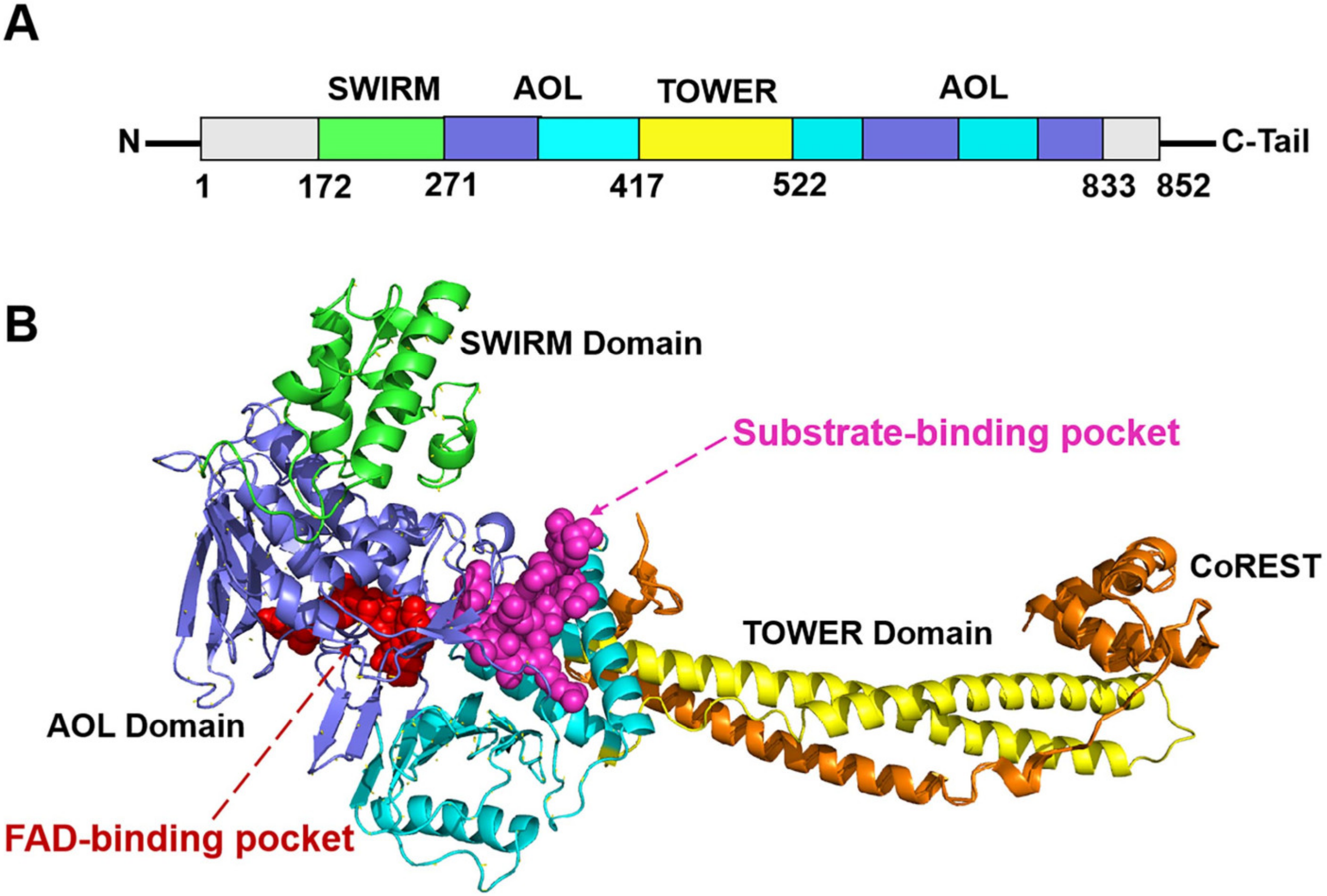

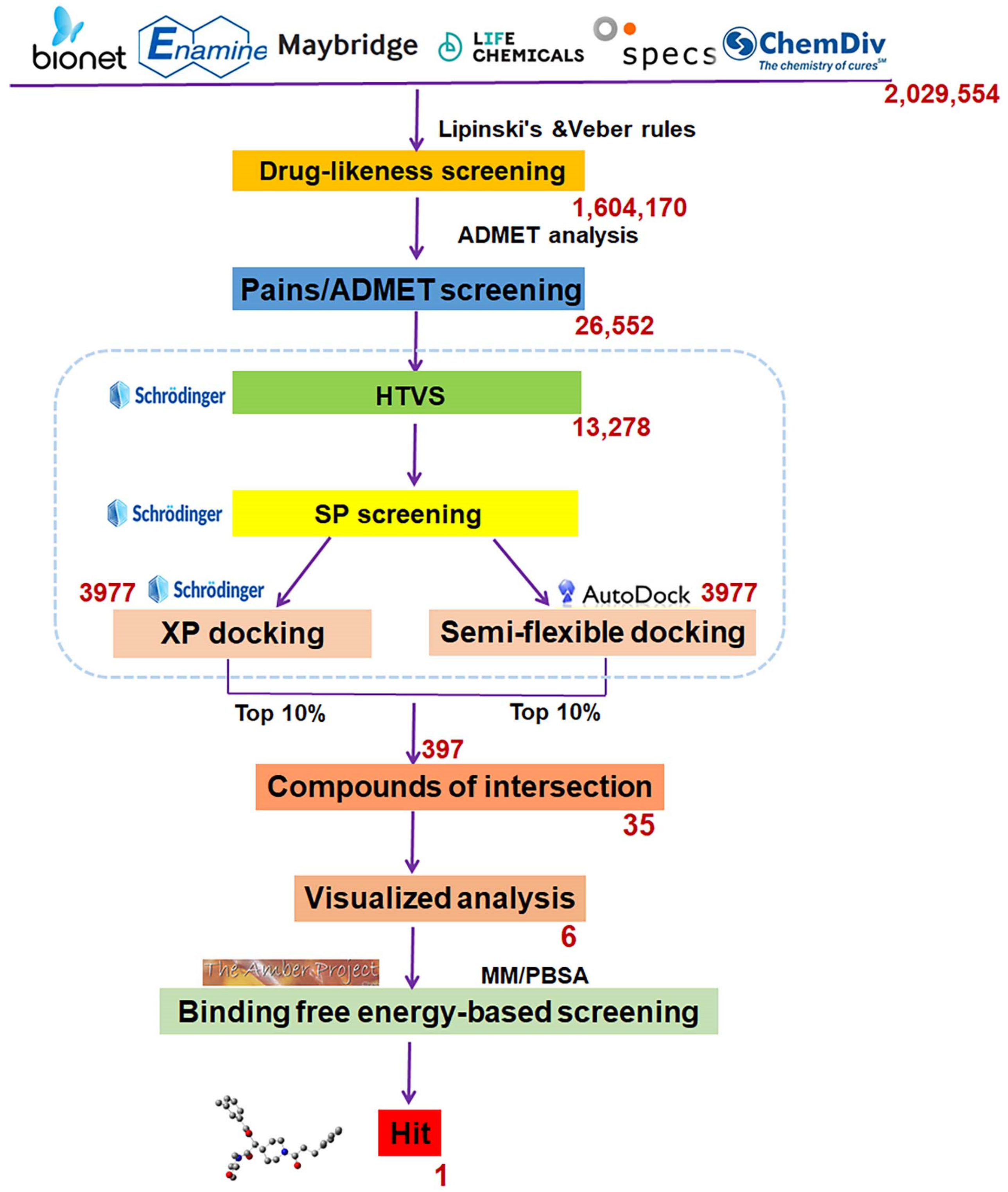

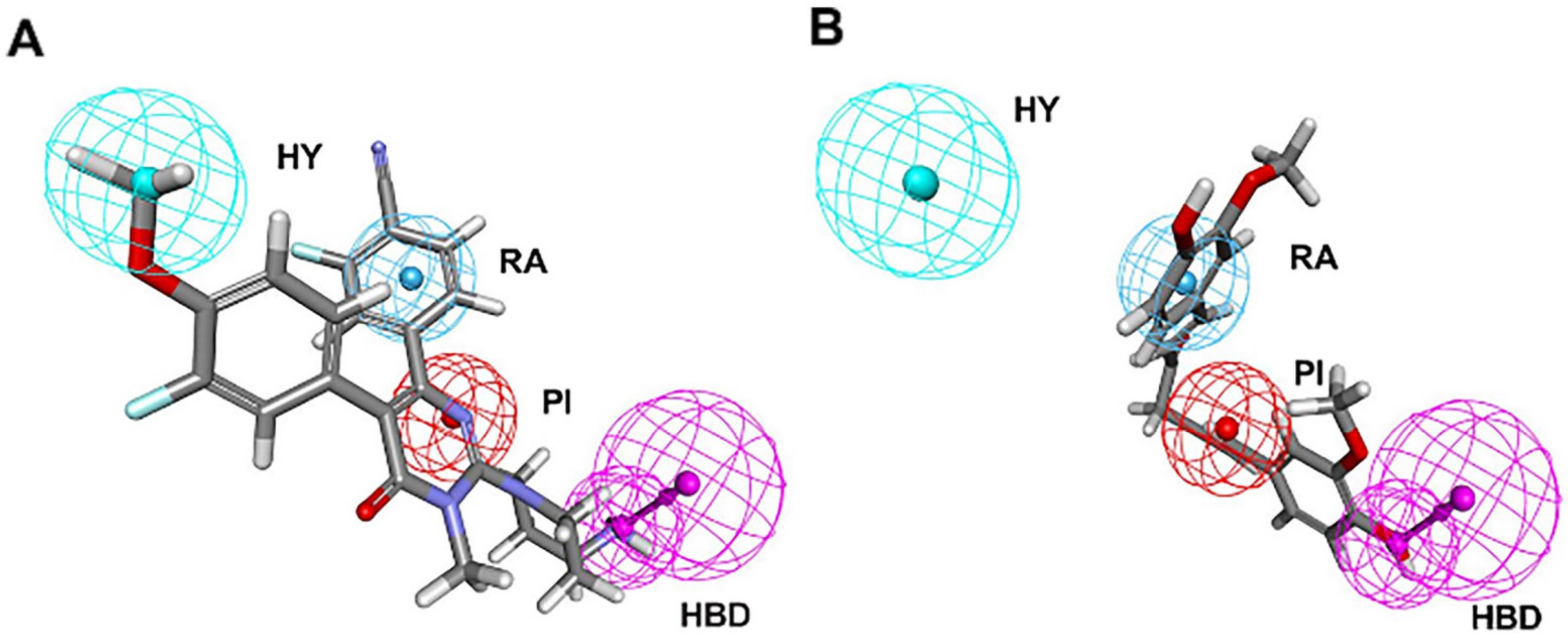




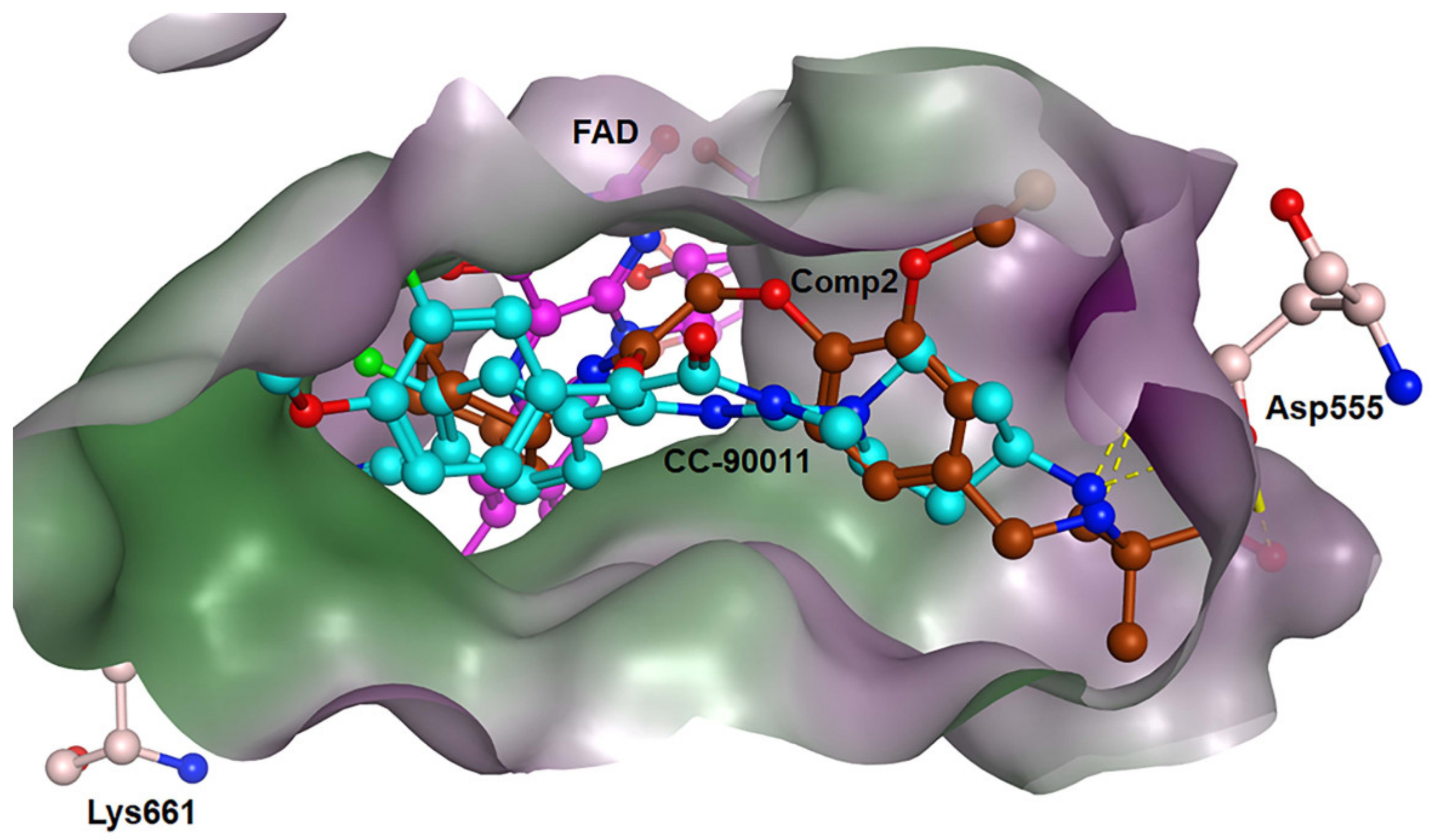
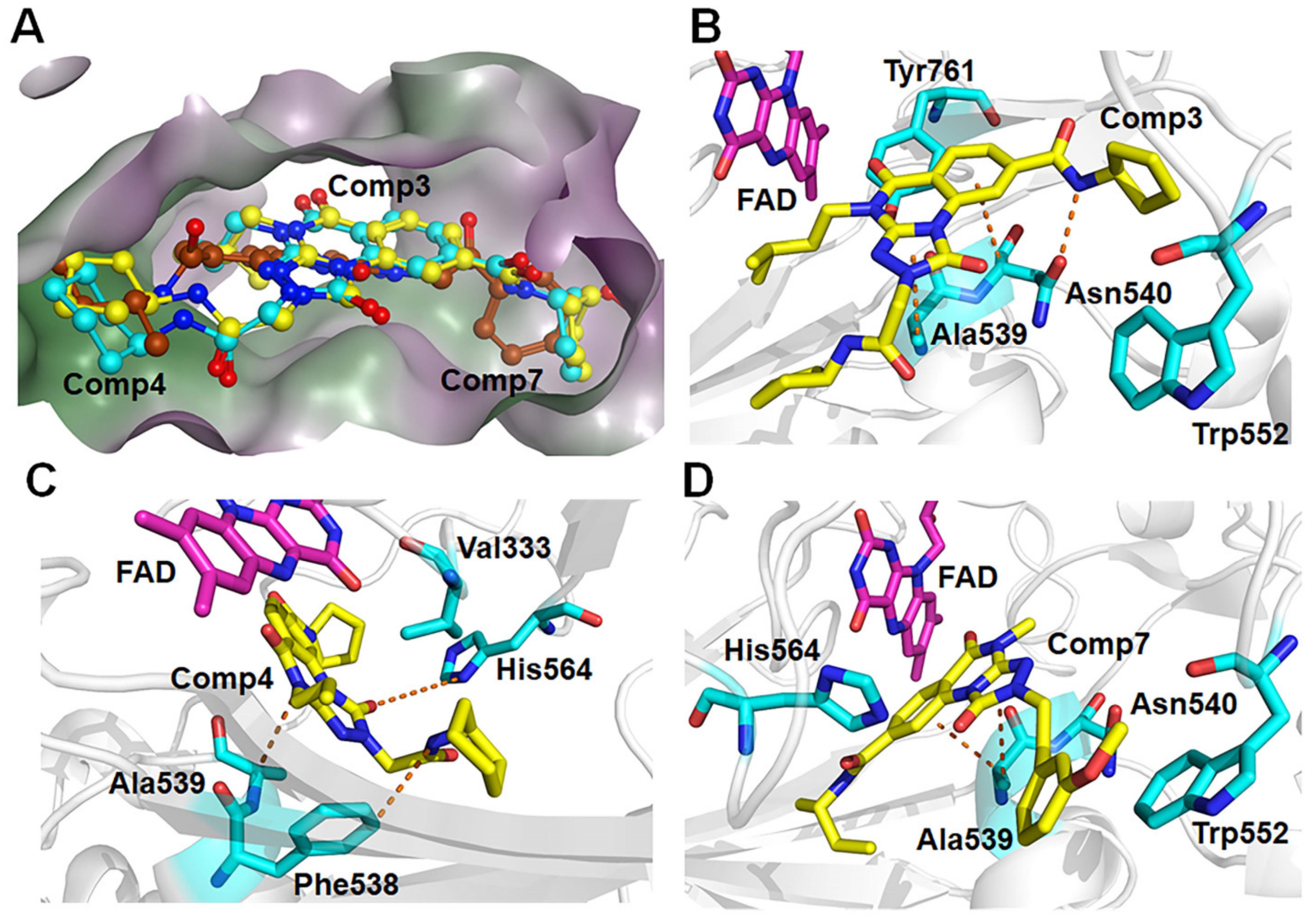
| Ligand | Structure | Ligand | Structure |
|---|---|---|---|
| 1 |  | 4 | 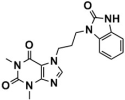 |
| 2 |  | 5 | 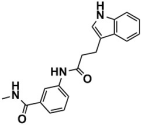 |
| 3 |  | 6 |  |
| Ligand | ΔEvdw | ΔEele | ΔGPB | ΔGnonp | ΔGbind |
|---|---|---|---|---|---|
| CC-90011 | −44.82 | −7.38 | 12.30 | −4.53 | −44.42 |
| (±0.03) | (±0.03) | (±0.04) | (±0.03) | ||
| 1 | −40.57 | −6.67 | 13.57 | −4.41 | −38.09 |
| (±0.05) | (±0.02) | (±0.02) | (±0.04) | ||
| 2 | −65.35 | −5.97 | 13.92 | −5.73 | −63.13 |
| (±0.04) | (±0.01) | (±0.01) | (±0.04) | ||
| 3 | −35.60 | −3.48 | 9.43 | −3.50 | −33.15 |
| (±0.04) | (±0.03) | (±0.03) | (±0.04) | ||
| 4 | −36.74 | −8.54 | 13.26 | −3.90 | −35.92 |
| (±0.05) | (±0.02) | (±0.02) | (±0.05) | ||
| 5 | −34.05 | −7.71 | 12.54 | −3.80 | −33.03 |
| (±0.05) | (±0.03) | (±0.02) | (±0.04) | ||
| 6 | −25.96 | −6.21 | 8.35 | −3.11 | −26.95 |
| (±0.07) | (±0.05) | (±0.04) | (±0.06) |
| Hypothesis | Total Cost | Cost Difference 1 | RMS | Correlation | Maximum Fit | Features 2 |
|---|---|---|---|---|---|---|
| 1 | 97.64 | 588.12 | 1.68 | 0.98 | 10.72 | HBD, RA, HY, PI |
| 2 | 103.83 | 581.93 | 1.86 | 0.97 | 10.36 | HBD, RA, HY, PI |
| 3 | 106.03 | 579.73 | 1.92 | 0.97 | 10.28 | HBD, RA, HY, PI |
| 4 | 108.51 | 577.25 | 2.00 | 0.97 | 9.69 | HBD, RA, HY, PI |
| 5 | 223.17 | 462.59 | 3.87 | 0.87 | 9.06 | RA, HY 2PI |
| 6 | 227.56 | 458.20 | 3.93 | 0.86 | 8.80 | HBD, RA, HY, PI |
| 7 | 236.46 | 449.30 | 4.03 | 0.86 | 9.26 | HBD, 2HY, PI |
| 8 | 237.41 | 448.35 | 4.05 | 0.85 | 8.40 | RA, HY, 2PI |
| 9 | 238.54 | 447.22 | 4.05 | 0.85 | 9.20 | HBD, 2HY, PI |
| 10 | 242.37 | 443.39 | 4.11 | 0.85 | 7.90 | 2HY, 2PI, |
| Compound | Experimental IC50 (nM) | Estimated IC50 (nM) | Error 1 | Experimental Scale 2 | Estimated Scale 2 | Fit Value 3 |
|---|---|---|---|---|---|---|
| 1 | 0.25 | 0.26 | 1.03 | +++ | +++ | 9.71 |
| 2 | 0.50 | 0.27 | −1.82 | +++ | +++ | 9.68 |
| 3 | 7.80 | 27.06 | 3.47 | +++ | +++ | 7.69 |
| 4 | 13.00 | 26.91 | 2.10 | +++ | +++ | 7.69 |
| 5 | 57.00 | 53.42 | −1.10 | +++ | +++ | 7.39 |
| 6 | 79.00 | 109.01 | 1.38 | +++ | +++ | 7.09 |
| 7 | 123.00 | 149.26 | 1.21 | +++ | +++ | 6.95 |
| 8 | 210.00 | 74.12 | −2.83 | ++ | +++ | 7.25 |
| 9 | 230.00 | 169.50 | −1.36 | ++ | +++ | 6.89 |
| 10 | 540.00 | 745.47 | 1.38 | ++ | ++ | 6.25 |
| 11 | 804.00 | 466.07 | −1.73 | ++ | ++ | 6.45 |
| 12 | 1850.00 | 5810.45 | 3.14 | ++ | + | 5.36 |
| 13 | 2200.00 | 5813.18 | 2.64 | + | + | 5.36 |
| 14 | 2800.00 | 5201.87 | 1.86 | + | + | 5.41 |
| 15 | 2900.00 | 5814.20 | 2.00 | + | + | 5.36 |
| 16 | 4000.00 | 1797.15 | −2.23 | + | ++ | 5.87 |
| 17 | 8130.00 | 5840.49 | −1.40 | + | + | 5.36 |
| 18 | 9500.00 | 5811.38 | −1.63 | + | + | 5.36 |
| 19 | 9600.00 | 5853.05 | −1.64 | + | + | 5.36 |
| 20 | 13,900.00 | 5811.33 | −2.40 | + | + | 5.36 |
| 21 | 16,000.00 | 5810.56 | −2.75 | + | + | 5.36 |
| Compound | Structure | Compound | Structure |
|---|---|---|---|
| 1 |  | 5 | 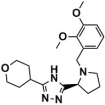 |
| 2 |  | 6 | 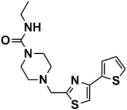 |
| 3 |  | 7 | 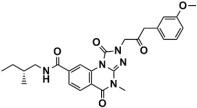 |
| 4 | 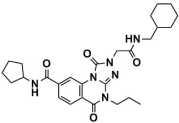 |
| Compound | ΔEvdw | ΔEele | ΔGPB | ΔGnonp | ΔGbind |
|---|---|---|---|---|---|
| CC-90011 | −44.82 | −7.38 | 12.30 | −4.53 | −44.42 |
| (±0.03) | (±0.03) | (±0.04) | (±0.03) | ||
| 1 | −41.84 | −6.12 | 11.09 | −4.24 | −41.10 |
| (±0.04) | (±0.03) | (±0.02) | (±0.04) | ||
| 2 | −50.32 | −6.67 | 13.33 | −4.85 | −48.51 |
| (±0.05) | (±0.03) | (±0.03) | (±0.05) | ||
| 3 | −51.50 | −5.40 | 11.17 | −5.32 | −51.06 |
| (±0.05) | (±0.04) | (±0.04) | (±0.05) | ||
| 4 | −57.03 | −1.51 | 9.90 | −5.62 | −54.26 |
| (±0.05) | (±0.03) | (±0.03) | (±0.05) | ||
| 5 | −35.49 | −6.53 | 10.41 | −4.02 | −35.63 |
| (±0.05) | (±0.02) | (±0.02) | (±0.05) | ||
| 6 | −37.26 | −2.97 | 8.17 | −4.14 | −36.21 |
| (±0.04) | (±0.02) | (±0.02) | (±0.04) | ||
| 7 | −47.85 | −5.90 | 12.53 | −5.24 | −46.45 |
| (±0.05) | (±0.02) | (±0.02) | (±0.05) |
Disclaimer/Publisher’s Note: The statements, opinions and data contained in all publications are solely those of the individual author(s) and contributor(s) and not of MDPI and/or the editor(s). MDPI and/or the editor(s) disclaim responsibility for any injury to people or property resulting from any ideas, methods, instructions or products referred to in the content. |
© 2023 by the authors. Licensee MDPI, Basel, Switzerland. This article is an open access article distributed under the terms and conditions of the Creative Commons Attribution (CC BY) license (https://creativecommons.org/licenses/by/4.0/).
Share and Cite
Yin, Z.; Liu, S.; Yang, X.; Chen, M.; Du, J.; Liu, H.; Yang, L. LSD1-Based Reversible Inhibitors Virtual Screening and Binding Mechanism Computational Study. Molecules 2023, 28, 5315. https://doi.org/10.3390/molecules28145315
Yin Z, Liu S, Yang X, Chen M, Du J, Liu H, Yang L. LSD1-Based Reversible Inhibitors Virtual Screening and Binding Mechanism Computational Study. Molecules. 2023; 28(14):5315. https://doi.org/10.3390/molecules28145315
Chicago/Turabian StyleYin, Zhili, Shaohui Liu, Xiaoyue Yang, Mengguo Chen, Jiangfeng Du, Hongmin Liu, and Longhua Yang. 2023. "LSD1-Based Reversible Inhibitors Virtual Screening and Binding Mechanism Computational Study" Molecules 28, no. 14: 5315. https://doi.org/10.3390/molecules28145315






